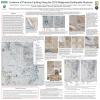Poster #006, Earthquake Geology
Surface rupture of the Little River fault in response to the August 9, 2020 Mw 5.1 earthquake near Sparta, North Carolina
Poster Image:

Poster Presentation
2020 SCEC Annual Meeting, Poster #006, SCEC Contribution #10742 VIEW PDF
al displacement between the ends of a 30-m-long building that is cut by the fault is 25.2 cm. This larger value indicates that the scarp accommodated part of the uplift but block rotation of the hanging wall is responsible for the remainder. Cracks at the top of the scarp accommodated folding of the asphalt but also opened oblique to the scarp trace, indicating a component of strike-slip motion. Average crack width is 0.45 cm and opening direction is 343°. Displacements projected onto a fault plane striking 100° and dipping 45°S yield a reverse fault with minor R-lateral motion, which matches slickenlines along fault exposed in a trench near the eastern tip of scarp. The trench reveals coseismic horizontal shortening of ~10cm along the fault plane (but it is likely greater near the center of the trace), plus evidence of multiple earlier movements with ductile shear fabrics, brittle faults with dip-slip slickenlines, and fault gouge and breccia within the deeply weathered bedrock. We interpret the LRF as having reactivated during the August 9 event, but it is unclear if this is the same surface that moved at depth or whether surface deformation is a subsidiary fault. Infrastructure damage and responses to USGS’s “Did you feel it?” app were more abundant south of the fault, which aligns with field evidence of a southern hanging wall moving NNE. The ESE-trending fault trace parallels linear structures crossing the NE-trending southern Appalachian orogen such as the Boone and the Mills Gap faults, which have evidence of Cenozoic deformation, but the LRF provides the first direct evidence of the surface expression of a seismically generated fault rupture related to a recent earthquake in the southern Appalachian Blue Ridge.
SHOW MORE
SHOW MORE






























